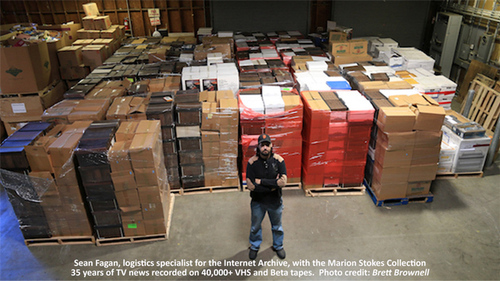The online archive plans to digitize 40 thousand video tapes

This is not a garage with books, but a warehouse with a collection of videos (40,000 tapes over 35 years)
When Trevor von Stein first heard the story of a woman named Marion Stokes, who had recorded television news on tapes for decades, he had a vague thought. Von Stein practically all information was in digital form - both music and photos. And he decided to help Stokes to digitize her materials.
Shortly thereafter, von Stein became a volunteer at the Internet Archive , a non-profit organization, proposing to transfer 40,000 cassettes to Stokes (she herself passed away in 2012). Von Stein spent six weeks studying the Stokes tapes. In particular, he found about 60 episodes of the TV show "Input", where he himself co-produced (1968-1971). Now these episodes are already in the Internet Archive, and you can download them .

')
And these episodes are the first step in digitizing cassettes recorded by Stokes. All of them, as reported above, about 40 thousand. At the same time, the Stokes family claimed that there were 140,000 tapes, however, this figure was significantly exaggerated. There is one more point - to save the cassettes they need to rewind in the cassette. It takes time. Simple cataloging of the 537 VHS tapes took about 16 hours for the employees of the fund (with additional work on entering meta-data).
 Plus, many materials are recorded on Betamax cassettes, while the readers for them have practically disappeared. There are a limited number of devices that can now work with Betamax, the rest were thrown out by owners as superfluous. Such devices are the authors of the project are trying to find on eBay and other online auctions.
Plus, many materials are recorded on Betamax cassettes, while the readers for them have practically disappeared. There are a limited number of devices that can now work with Betamax, the rest were thrown out by owners as superfluous. Such devices are the authors of the project are trying to find on eBay and other online auctions.Digitization of tapes, according to the TV division of the Internet Archive, requires significant funds - about half a million dollars. And most of the money still needs to be found. Archive now depends mainly on volunteers like von Stein, who see in old records not just talking heads, but important information, a kind of portal into the past.
Source: https://habr.com/ru/post/366031/
All Articles